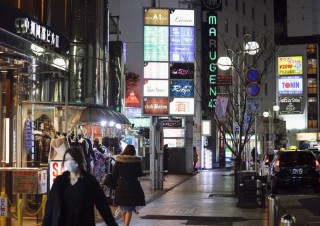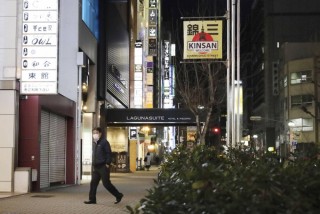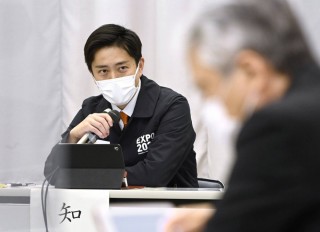Loading
Search
▼ Japan Likely To Maintain Virus Emergency In 10 Prefectures For Now
- Category:Other
The government is leaning toward leaving in place the state of emergency declared in 10 prefectures, at least for this week, media reports said Wednesday, instead of lifting it in three prefectures.
Multiple media outlets, including Fuji TV, reported that Prime Minister Yoshihide Suga’s administration is in the final stages of making a decision on maintaining the emergency declaration. It is currently in effect for Tokyo, Kanagawa, Saitama, Chiba, Osaka, Hyogo, Kyoto, Gifu, Aichi and Fukuoka prefectures.
The central government was initially considering downgrading three prefectures — Aichi, Gifu and Fukuoka — from the state of emergency to a new measure effective Saturday that would allow local governors to adopt flexible COVID-19 countermeasures while still being able to order powerful restrictions, such as ordering businesses to close early or even completely on a temporary basis.
The government was initially optimistic and tilting in favor of lifting the declaration early, as it imposes restrictions on daily life, according to one senior administration official. Politically, however, it would be a safer bet for Suga to shield himself from further criticism of his approach to fighting the health crisis by keeping the emergency in place, and then trying to reboot the economy.
Multiple media outlets, including Fuji TV, reported that Prime Minister Yoshihide Suga’s administration is in the final stages of making a decision on maintaining the emergency declaration. It is currently in effect for Tokyo, Kanagawa, Saitama, Chiba, Osaka, Hyogo, Kyoto, Gifu, Aichi and Fukuoka prefectures.
The central government was initially considering downgrading three prefectures — Aichi, Gifu and Fukuoka — from the state of emergency to a new measure effective Saturday that would allow local governors to adopt flexible COVID-19 countermeasures while still being able to order powerful restrictions, such as ordering businesses to close early or even completely on a temporary basis.
The government was initially optimistic and tilting in favor of lifting the declaration early, as it imposes restrictions on daily life, according to one senior administration official. Politically, however, it would be a safer bet for Suga to shield himself from further criticism of his approach to fighting the health crisis by keeping the emergency in place, and then trying to reboot the economy.
A decision was expected ahead of a government advisory committee meeting slated for Friday, the day before revisions to the law on coronavirus measures and other relevant infectious disease prevention legislation take effect, through which the government will reflect changes in its basic policy on virus countermeasures.
Government officials are still worried that hospitals are being overwhelmed by COVID-19 patients and the situation needs to improve before lifting the emergencies. As of Monday, 50.5% of available hospital beds for COVID-19 were in use in Aichi, while the figure stood at 36.5% in Gifu and 69.4% in Fukuoka.
The cautious approach also reflects the reality that although the overall number of new COVID-19 cases is falling in the 10 prefectures, the number of people receiving treatment at hospitals is still high. Public health experts and doctors had expressed worries that the operation of hospitals, including treatment for patients without COVID-19, would collapse beyond the point of recovery if the restrictions were removed in haste for the sake of the economy.
“The most important thing is reducing the death toll and the number of serious cases and unburdening the health care system as soon as possible,” Dr. Shigeru Omi, the chair of the government’s subcommittee on COVID-19 measures, said Tuesday night.
“If the emergency declaration is removed too quickly, a rebound in the number of new cases will be bigger and the overall economic blow will be much larger.”
The government decided to extend the state of emergency through March 7 last week to ensure the pandemic is stifled to a sufficient point that it can roll back current limitations, which have primarily targeted restaurants’ business hours.
Government officials are still worried that hospitals are being overwhelmed by COVID-19 patients and the situation needs to improve before lifting the emergencies. As of Monday, 50.5% of available hospital beds for COVID-19 were in use in Aichi, while the figure stood at 36.5% in Gifu and 69.4% in Fukuoka.
The cautious approach also reflects the reality that although the overall number of new COVID-19 cases is falling in the 10 prefectures, the number of people receiving treatment at hospitals is still high. Public health experts and doctors had expressed worries that the operation of hospitals, including treatment for patients without COVID-19, would collapse beyond the point of recovery if the restrictions were removed in haste for the sake of the economy.
“The most important thing is reducing the death toll and the number of serious cases and unburdening the health care system as soon as possible,” Dr. Shigeru Omi, the chair of the government’s subcommittee on COVID-19 measures, said Tuesday night.
“If the emergency declaration is removed too quickly, a rebound in the number of new cases will be bigger and the overall economic blow will be much larger.”
The government decided to extend the state of emergency through March 7 last week to ensure the pandemic is stifled to a sufficient point that it can roll back current limitations, which have primarily targeted restaurants’ business hours.
The revised legislation set to be enforced Saturday also introduces new steps to prevent further spread of the virus, with a status one step below a state of emergency enabling prefectural governors to order businesses to close early and designate an area as being subject to enhanced control by a municipality, thereby giving more flexibility to local leaders.
In any case, even prefectures that had been considering requesting the central government to downgrade the emergency level have ultimately decided to hold off for now.
Osaka Gov. Hirofumi Yoshimura has introduced the prefecture’s own standard for rolling back restrictive measures: either the average number of new COVID-19 patients is 300 or less for seven straight days, or the occupancy rate of hospital beds for critical cases is 60% or below for the same length of time.
The prefecture met the first target Monday, but the second figure was 61.9% as of Tuesday.
Yoshimura had initially intended to ask the central government to lift the state of emergency but had second thoughts after seeing the figures.
“Although the situation has improved, hospital beds are under a high level of strain,” he said at a news conference Wednesday, adding that the prefecture will convene a task force meeting next week to determine whether it will ask the central government to rescind the state of emergency in Osaka.
In any case, even prefectures that had been considering requesting the central government to downgrade the emergency level have ultimately decided to hold off for now.
Osaka Gov. Hirofumi Yoshimura has introduced the prefecture’s own standard for rolling back restrictive measures: either the average number of new COVID-19 patients is 300 or less for seven straight days, or the occupancy rate of hospital beds for critical cases is 60% or below for the same length of time.
The prefecture met the first target Monday, but the second figure was 61.9% as of Tuesday.
Yoshimura had initially intended to ask the central government to lift the state of emergency but had second thoughts after seeing the figures.
“Although the situation has improved, hospital beds are under a high level of strain,” he said at a news conference Wednesday, adding that the prefecture will convene a task force meeting next week to determine whether it will ask the central government to rescind the state of emergency in Osaka.
- February 10, 2021
- Comment (0)
- Trackback(0)




